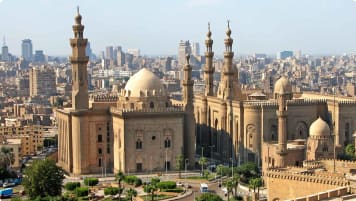Ottoman Empire: The Definitive Guide for Travellers
The Ottoman Empire, c. 14th-20th centuries | Small group history tours Turkey The Ottoman Empire once extended from Iraq to North Africa, from Arabia to the Balkans, even pressing to the walls of Hapsburg Vienna…
3 Oct 19 · 15 mins read

The Ottoman Empire, c. 14th-20th centuries | Small group history tours Turkey
The Ottoman Empire once extended from Iraq to North Africa, from Arabia to the Balkans, even pressing to the walls of Hapsburg Vienna on two separate occasions. Originating from a Central Asian tribe, The Ottoman Turks established a beylik, or principality, in the 13th century. In 1453, under the rule of Sultan Mehmet II (‘The Conqueror’) the Ottomans captured Constantinople. This city would become the heart of Ottoman power.
This extensive land empire would last until 1924, leaving behind a legacy of art, architecture and culture. Its Golden Age would prove to be the 16th century, especially during the rule of Sultan Suleiman ‘The Magnificent’ (1520-1566). Under his administration, the Ottoman state ruled over 15 to 25 million people. Although scholars no longer believe the empire declined after his death, it is described as a watershed moment, after which political, economic and institutional conditions would begin to transform.
As a culture, the Ottomans were great patrons of the arts and many talented artists and craftsmen were drawn to its vibrant cities. Thanks to chief architect Sinan, these cities were synonymous with sprawling mosque complexes and the distinctive floral style that distinguishes this historic empire. Lucky for us, many buildings and artefacts remain intact so that we can be transported back in time to a faraway and truly unique place. This article details some of the most impressive cultural artefacts from the Ottoman Empire, weaving together fascinating chapters of history.
After a look at the art and architecture of the Ottoman Empire, we then consider the ways that the Empire was represented in European art. In the Early Modern period, Turkey seemed an existential threat to Europe’s existence, while by the 18th and 19th centuries, the Ottoman Empire came to signify a sensuous luxury denied to Europeans.
For more information on the history of Turkey, take a look at our other articles about the Ottoman Empire:If you’re eager to visit Turkey, you may also be interested in some of our lists:
- Ten Unimaginable Destinations (including the underground city of Derinkuyu)
- Ten Books for Travellers to Turkey
- Ideas for Visiting Turkey
- An overview of the history of Turkey
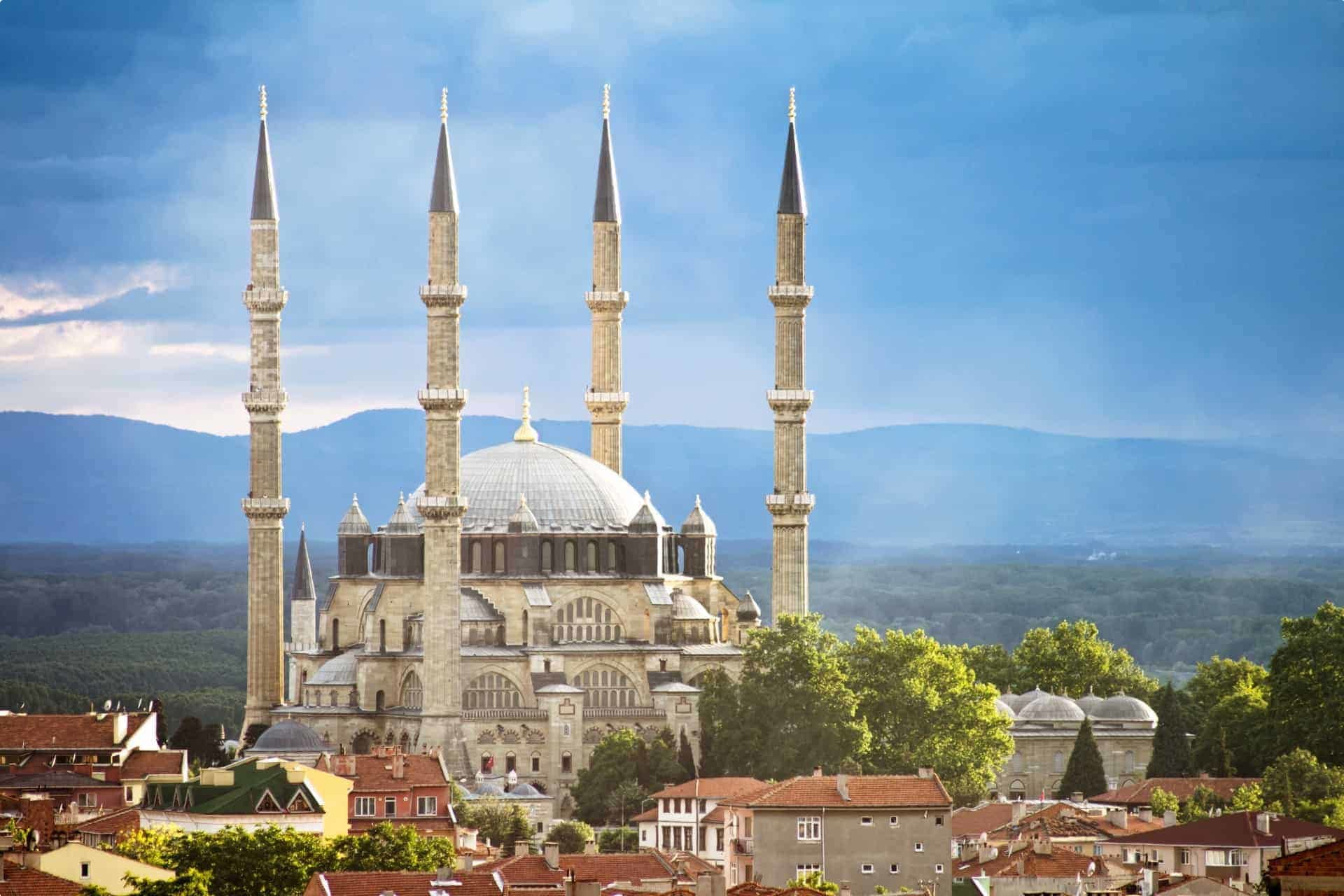
Selimiye Mosque in Edirne, Turkey
Early Ottoman Architecture
Early Ottoman architecture represents the merging of traditions, as the Ottomans sought to expand their dominion into the weakened Byzantine Empire. The early Ottoman capitals of Bursa, Iznik, and Edirne showcase the early Ottoman style. These buildings were modest in scale but ambitious in design, and experts believe they reflect the influences of Byzantium.
Awe-inspiring domes are a mainstay of Ottoman architecture, and the Islamic influence can be inferred from their stunning exteriors. But it is the treatment of the spaces beneath the domes that reveal the exciting melange of Byzantine history and Ottoman originality. The earliest surviving mosques are cubic buildings topped by great domes set on squinches that tended to enclose the interior space. Builders were inspired to increase the space without breaking up the unity, so the solution was to increase the number of domes and to place them atop elegant arches resting on pillars or columns.
The best representation of this innovation is the Ulu Cami, or Great Mosque in Bursa, built between 1396-1400. Twenty domes are supported by twelve columns; however, the sense of expansiveness is still somewhat marred. A second example is the Eski Cami Mosque in Edirne which showcases nine domes supported by four pillars. It is speculated that this building demonstrates the influence of a Byzantine adaptation by which a central bay is surrounded by smaller bays, allowing for a less obstructed sense of interior space.
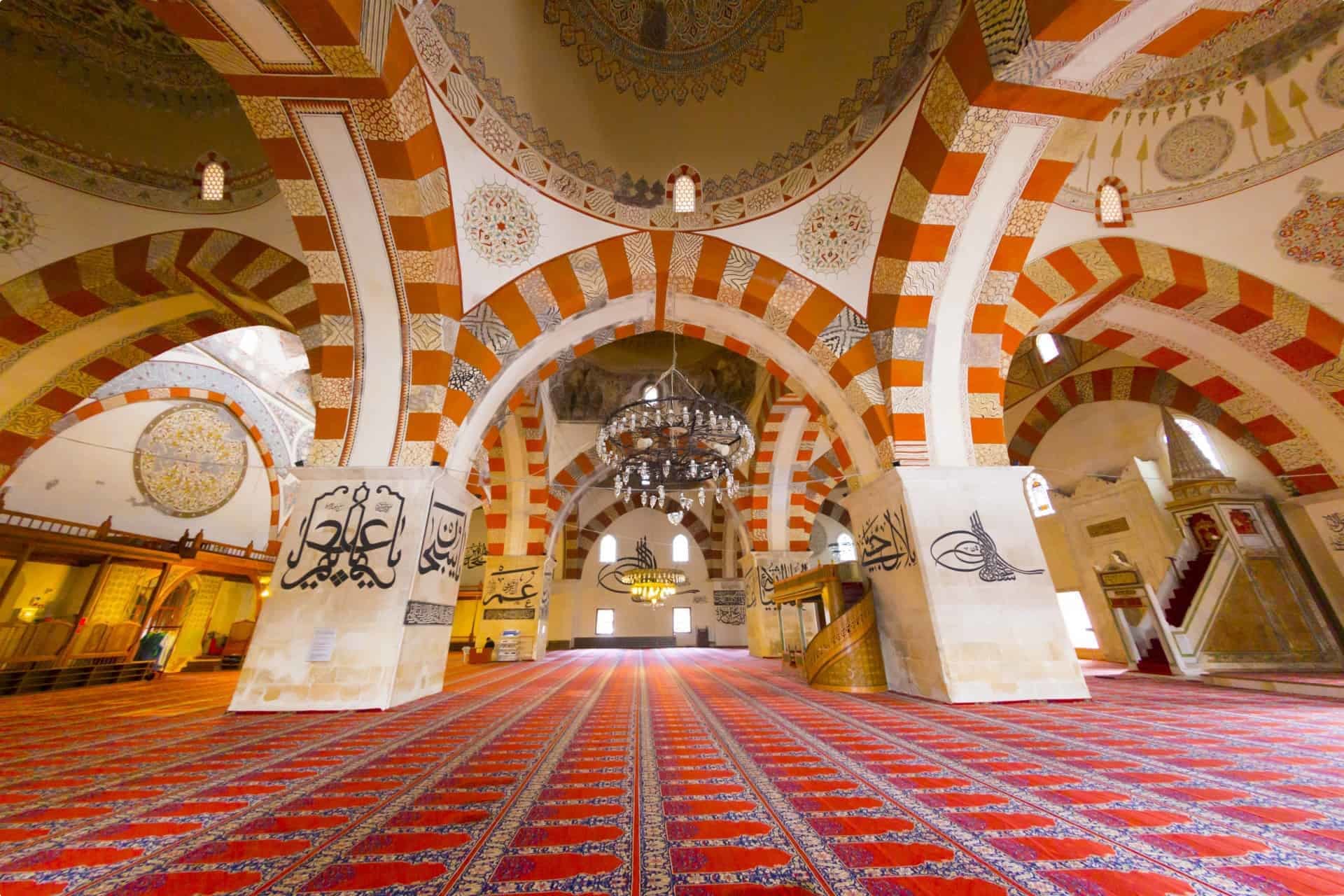
Such an adaptation can be seen in the late 14th century Didymoteicho Mosque, a Byzantine structure featuring a wide central bay crowned with a dome and surrounded by eight smaller bays. This arrangement appears in Byzantine buildings scattered across the Balkans, including the 1028 church of Panagia ‘ton Chalkeon’ in Thessaloniki.
The Ottoman Empire took Constantinople in 1453, after which they consciously adopted Byzantine prototypes for Ottoman mosques for a time. However, this is evidence that while they were growing in power, they were influenced by the models of their Byzantine predecessors. The century prior to the 1453 conquest is also rich in architectural history and can provide us with some understanding of how the Ottoman Empire developed.
Constantinople
On conquest of the venerated city of Constantinople, Sultan Mehmet II earned himself the epithet ‘The Conqueror’. The first mosque to be built here under Ottoman reign was called Fatih Mosque or Faith mosque, a name that survives its collapse and reconstruction in 1771. Thankfully, the original plans were also upheld. Because of this, we are able to experience its central domed roof and lateral bays – features of pre-1453 mosques of Bursa, Edirne and Didymoteicho. However, the Faith Mosque announced a new innovation in the form of a large semidome that supports the main dome on the qibla side: toward the direction of prayer. This would later develop into the main architectural feature of Classical Ottoman mosques.
This design reflects the 6th century Hagia Sophia, and came to be a prototype for 16th century mosque architecture. Sinan, principal architect of the Ottoman Empire, erected the most faithful reconstruction of the Hagia Sophia in the Suleymaniye Mosque. It bears a striking resemblance to the Byzantine cathedral in its proportions and floor plan, however its lofty arches further open the impressive interior space.
Sultanic mosques tended to adhere to formal prototypes, leaving smaller buildings to trial architectural innovations. Other buildings reflected Islamic traditions, such as the bathhouses and shops that popped up around the mosques. These provided financial aid to cover the running costs and charitable operations of these institutions, and provide another source of insight into their history.
Tiles and decorative arts
Classical Ottoman mosques are beloved for their grandeur, with impressive structures that balance a sense of expansive interior space. But this grandeur is attributed not only to their floor plan but to the decorative arts that adorned them.
Intricate and colourful tiles were commissioned from workshops in Istanbul and Iznik. Few other decorative materials survive; stained glass windows, for instance, are often damaged while wall paintings have been renewed several times over. These tiles, however, preserve the decorative schemes of the 16th century. Experts suspect that polished marble floors were covered during winter months with opulent carpets, to be unveiled to the light of the hot summer months.
The Rustem Pasha mosque in Istanbul houses a truly impressive example of Classical Ottoman decoration. Built by architect Sinan, its unassuming exterior belies an ornate and profuse space within, where tiles retain their artful arrangement in panels on the walls.
Sinan the architect
Sinan was the most important architect in Istanbul and his career spanned the reign of three sultans. His portfolio features hundreds of examples of Ottoman monuments, and Sinan was revered even during his lifetime. His greatest achievement was the Suleymaniye Mosque, which is said to have exceeded its Hagia Sophia prototype for its magnificent and unobstructed interior space.
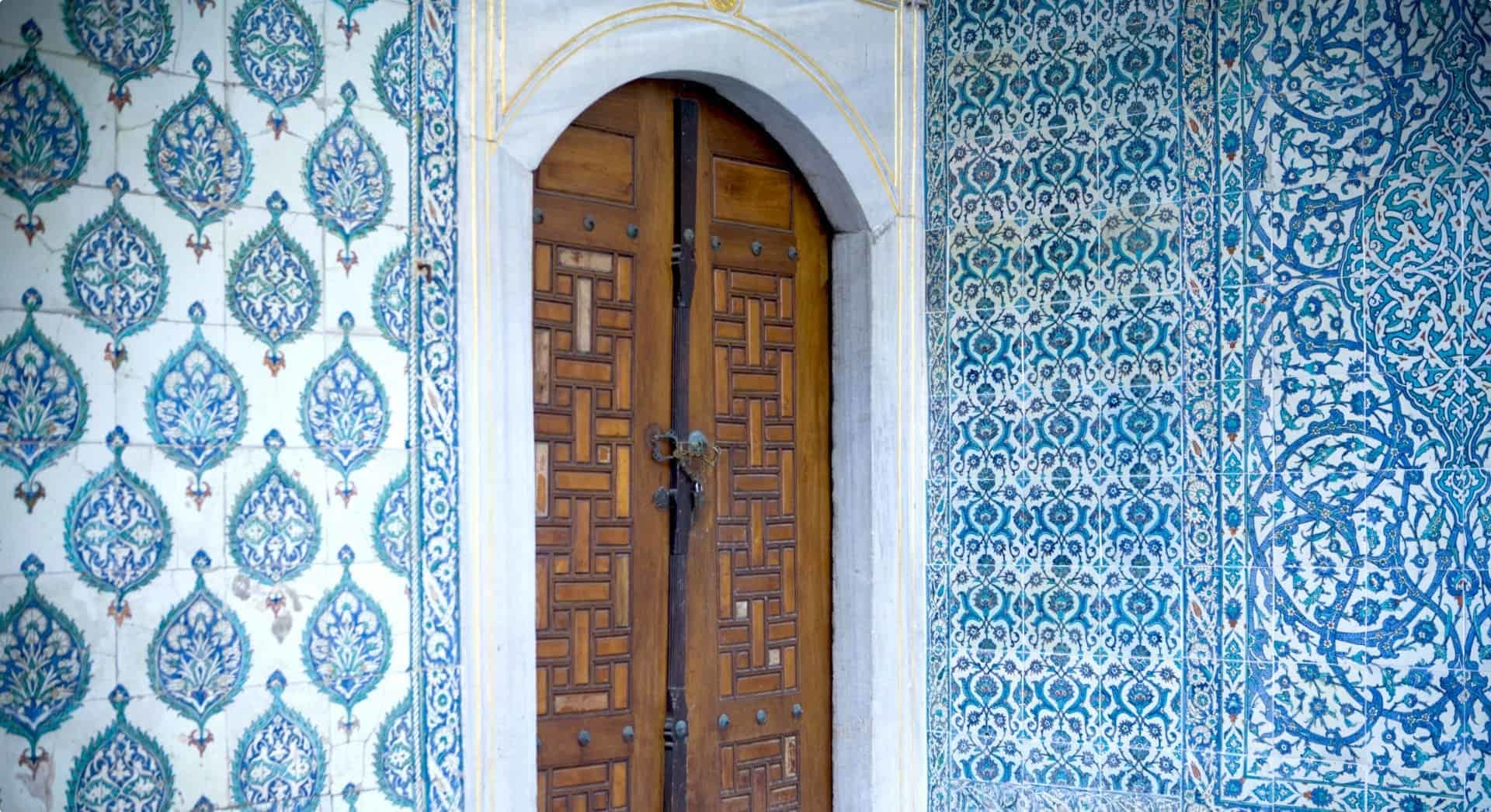
Topkapi Palace
Topkapi Palace was founded by Mehmet II in the 1450s. Initially called the New Palace, it was built to seat the administration while the royal family was housed at the Eski Saray or ‘Old Palace’ nearby. However, the royal family moved in once private quarters were added in the late 16th century.
This sophisticated complex of buildings is organised around a sequence of courtyards with increasingly restricted access and privacy. It is this distinctive layout that impresses upon the imagination of visitors today. This palace was the seat of government for the entire Ottoman Empire and imperial residence for four consecutive centuries. The interiors were regularly updated and so reflect the tastes of the different periods from the 16th through to 18th centuries.
Access was highly regulated by the structure of the complex itself. The first court is accessed via the Gate of Majesty, where the Imperial mint and Hagia Irene stand. The middle gate, or Gate of Salutation required that everyone dismount in order to gain access to the second court (excepting the sultan himself). In this second court stood the extensive kitchens, Imperial Treasury, Divan, and seat of the government council. A third gate (the Gate of Felicity) granted access to a select few. On the other side, the third court or ‘Inner Palace’ featured a Chamber of Petitions, Library of Ahmet III, the Mosque of the Aghas (one of the complex’s oldest constructions), Dormitory of the Royal pages and Privy Chamber.
The inner sanctum
The harem was added at the end of the 16th century, and the sultan accessed this space from the third chamber. It was itself a complex of palatial proportions made up of individual apartments numbering over 400. Many were designed by architect Sinan, and included mosques, hammams or bathhouses and warehouses. The sultan’s mother, wives, concubines, children, and their servants resided here.
A fourth courtyard has been distinguished by experts who believe this was the innermost sanctum of the sultan and his family. Today, visitors can appreciate the lofty quarters once reserved for the elite. The intricately decorated Circumcision Chamber is located here, which was dedicated to the circumcision of young princes. Across decorative pools stands the Baghdad Kiosk decked with marble, porphyry and ophite, along with blue and white tiles to match the Circumcision Chamber. Today, visitors to Topkapi Palace marvel not only at its architecture but its remarkable museum collection from the Royal Treasury.
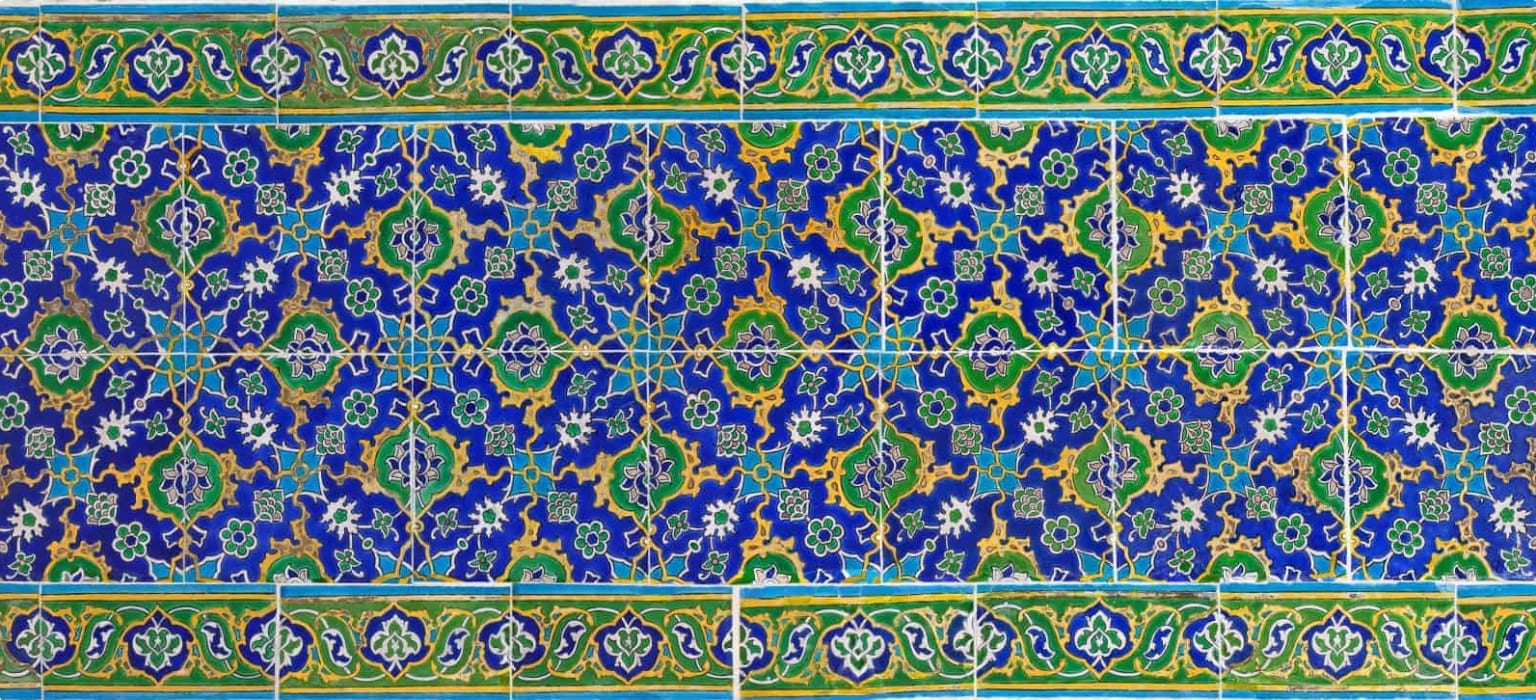
Carpets
The finest Ottoman carpets were produced in Ushak in Western Anatolia. These carpets were beloved during the Ottoman Empire and across the world, and they reflect the tastes and styles of the past.
Ottoman carpets were characterised by their fine designs and intricate, repeated motifs. They were dominated by rich red hues, sometimes adorned with green, white, yellow and blue flourishes. Carpets from this period are divided into groups based on design. Most notable among these are the ‘Star Ushaks’ and ‘Medallion Ushaks’, their names denoting the predominant scheme. Another category is the prayer rug or saf which carried an image of a mihrab or niche. This image was pointed toward Makkah as worshippers prayed upon these carpets. Some were made for single use, while others were shared. These impressively long carpets featured several woven niches. Few prayer rugs survive today; a reflection of their extensive and daily use.
Many Ottoman carpets were exported to Europe, especially via Italy, from the 15th century onward. These were prestigious possessions often ordered by members of the nobility and church, and they appear in portraits and sacred church paintings. Henry VIII was a notable collector, having some 500 carpets in his possession at the time of his death.
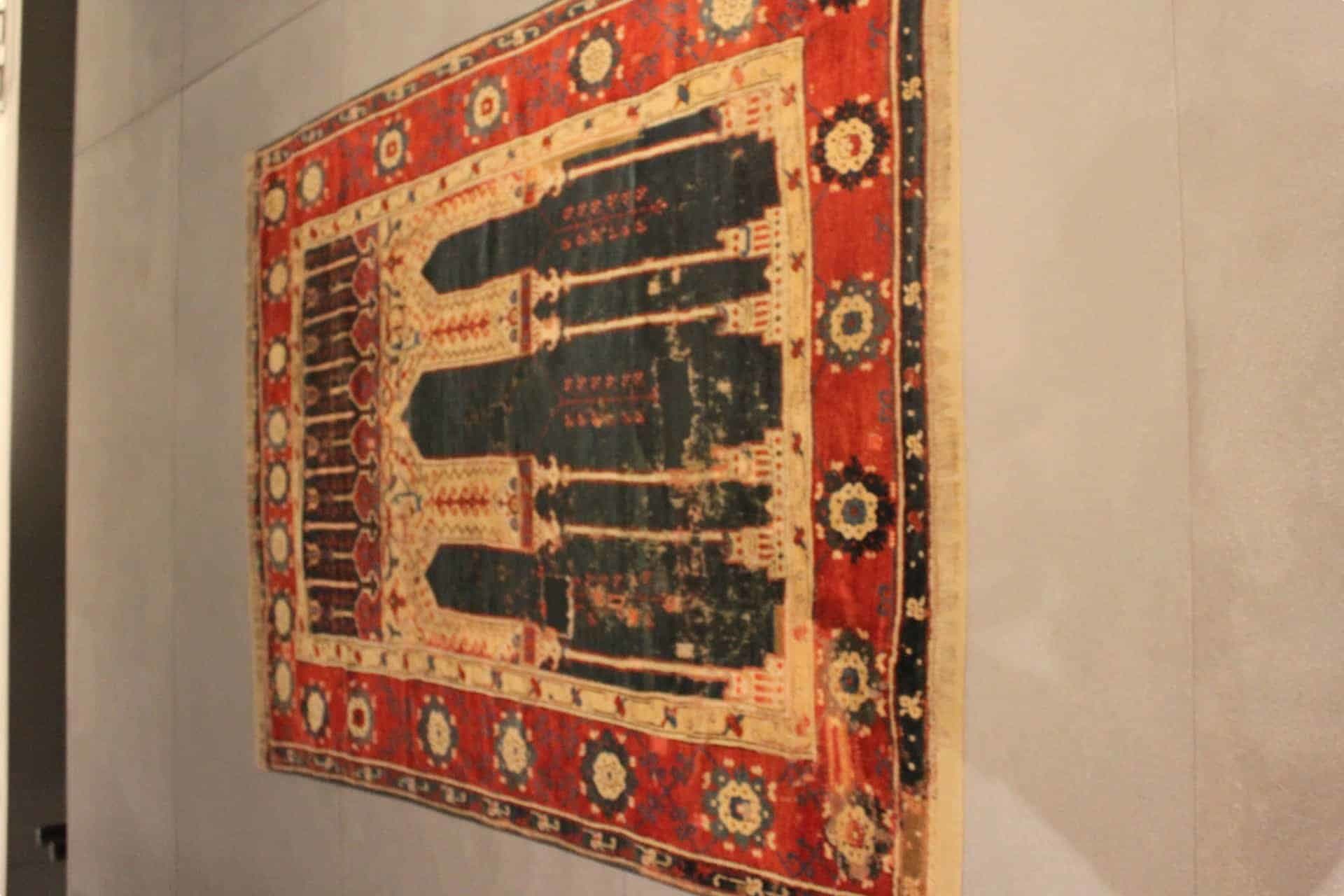
The Ottomans conquered Egypt in 1517, granting them access to the highly skilled carpet makers of Mamluk Cairo. Prior to the Ottoman conquest, Mamluk designs tended to be kaleidoscopic in character, featuring octagon and star patterns in blues, greens and cherry red. The Ottoman influence led these craftsmen to produce more floral patterns, featuring hyacinths and carnations, for instance.
In 1585, demand for carpets was so high that Sultan Murad III called 11 carpet makers from Cairo to Istanbul to assist the 16 master carpet makers already stationed in the Ottoman capital. It is believed this led to something of an Egyptian flourish in carpets once again as the two traditions worked together to meet demand and send their wares throughout the world.
Iznik pottery
The Ottoman Empire is synonymous with the colourful tiles that adorn buildings and the vessels enhanced by distinctive patterns and designs. Typical Iznik pottery is distinguished by a hard, white body coated in a white slip of fine, liquid clay, and of course, the brilliance and gloss of the transparent glaze illuminating intricate and colourful scenes.
The production of glazed earthenware in Iznik dates back to the 13th century, when it was known by its former name Nicaea. In the 15th century, a new stoneware technique was introduced by potters from Iran. We know this because tiles adorn the mosque of Sultan Mehmet in Bursa, and these were signed by “the masters of Tabriz”, referring to a city in Iran.
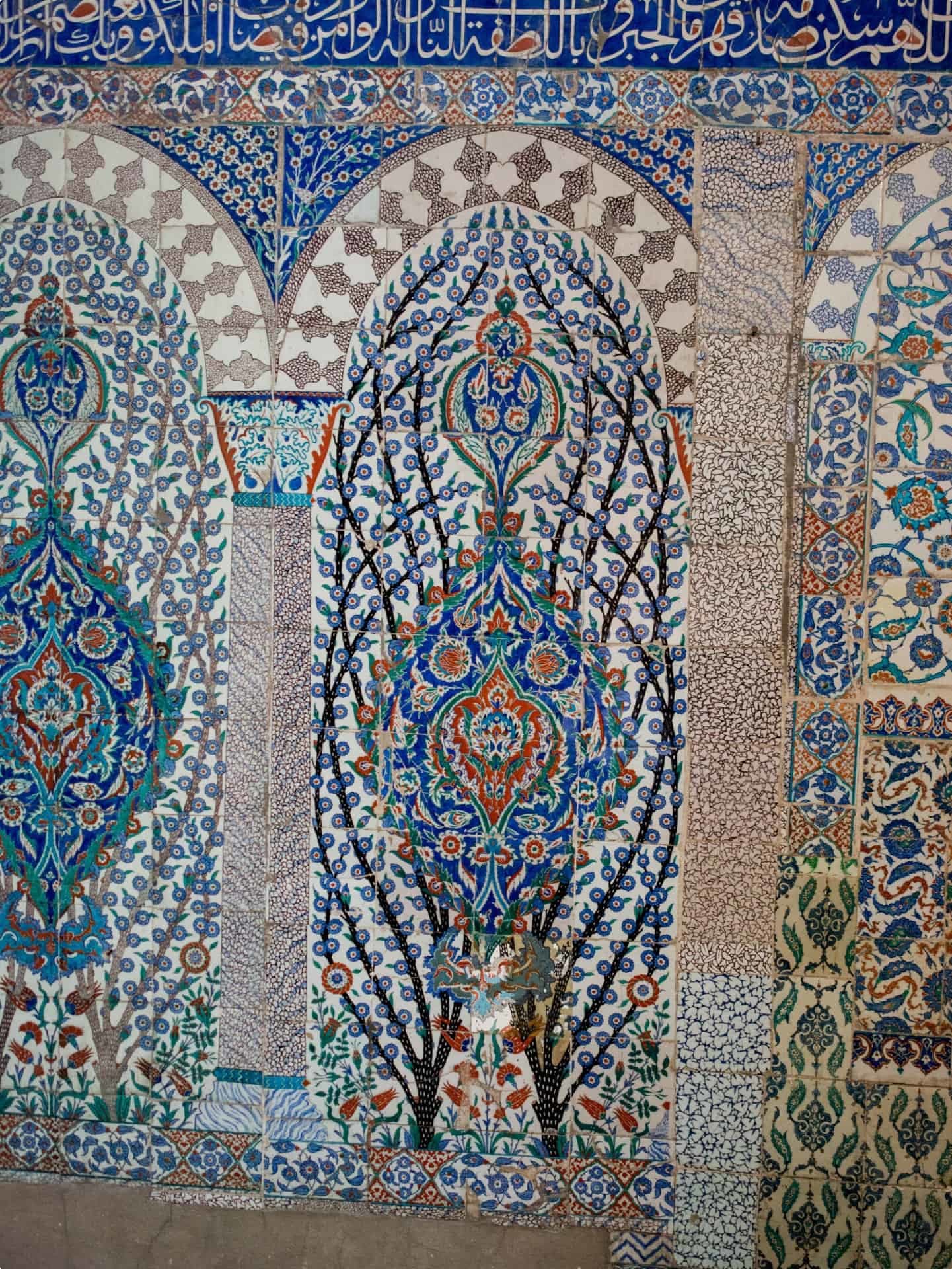
A thriving industry
Come the late 15th century, large-scale production was underway. Much of it came out of imperial workshops in Istanbul. Here, designs were applied by stencil. Intricate pictures and patterns were drawn onto wax paper and the outlines were pricked with tiny holes. The paper was laid over the tile or vessel and sprinkled with charcoal dust leaving an imprint in place to be completed with colour and artistic flair.
In 1514, Sultan Selim captured the city of Tabriz, bringing back master craftsmen including tile cutters and painters. Among them was Shahquli Baghdadi who was installed as head of the workshop in 1526. Shahquli soon rose to the highest rank in the palace atelier, where he remained until his death in 1556.
It is believed the first phase of Iznik pottery design reveals traces of influence by Chinese porcelain, along with radial patterns of Ottoman metalwork. Tightly drawn, white arabesques were set into a dark coloured background but as the 15th century drew to a close, blue colours became paler, white was used more liberally, and designs ‘loosened’ as a result.
The saz motif
With the arrival of Shahquli came a recognisably Persian style typified by the saz motif. This was a foliate composition with feather-like leaves often accompanied by wild animals, mythical creatures and rosette-style flowers. These beautiful designs were developed and refined under the Ottoman Empire.
During this period, Iznik potters received a massive commission. A series of five 125cm tiles were ordered for display in the Circumcision Chamber of Topkapi Palace. These massive pieces were decorated with animals and landscapes in hues of blue and turquoise. This would have been a significant job given the Circumcision Chambers sits within the so-called ‘Inner Sanctum’ of the Sultan’s palace.
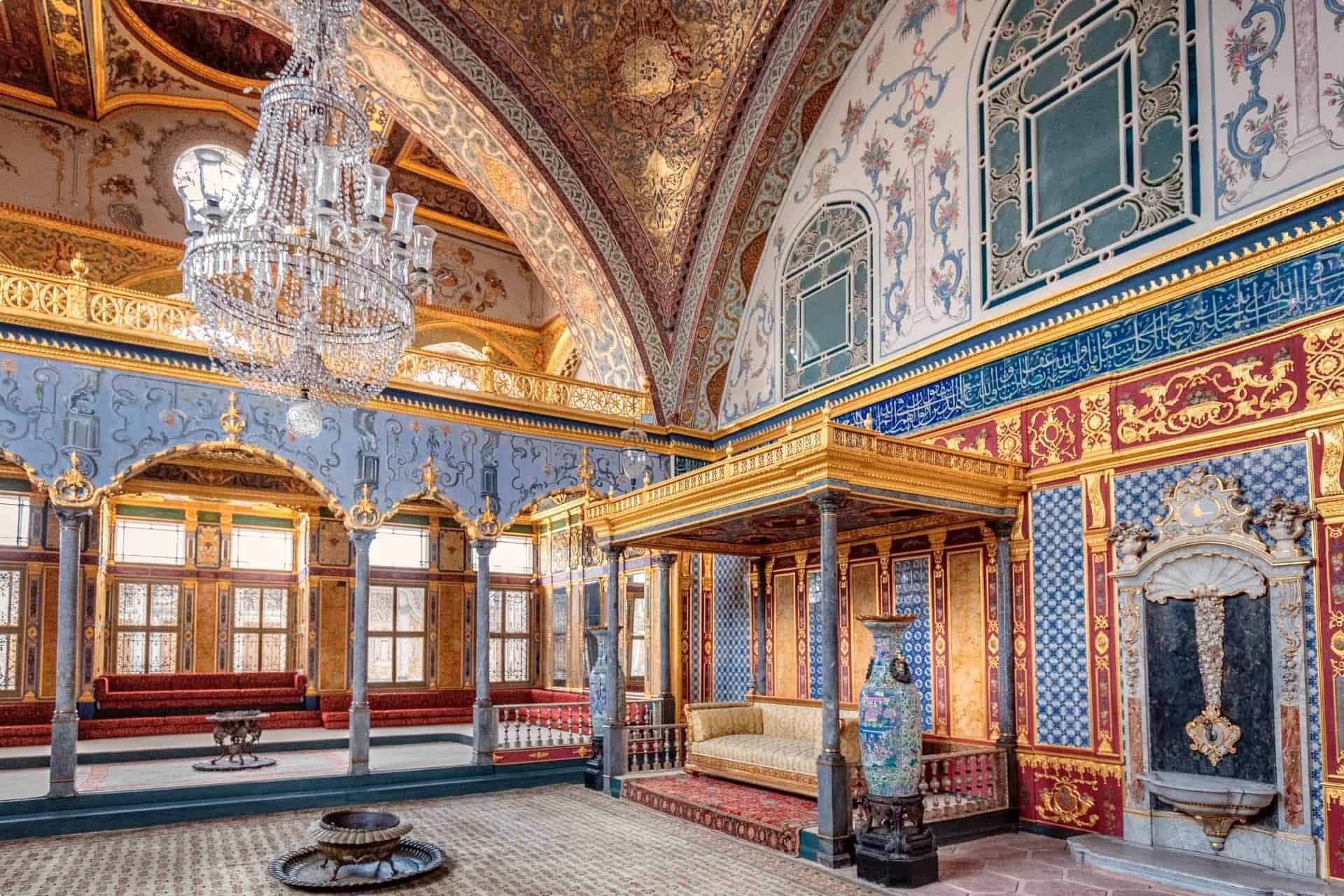
An evolving artform
Under the reign of Suleiman the Magnificent (1520-1566) the Iznik pottery style was further refined. Suleiman was a great patron of the arts, and from 1550, tile making become the preeminent concern for workshops as many religious buildings were commissioned. While the colour palette had softened at the beginning of the 16th century, viewed from a distance these results were deemed murky and indistinct. Further changes to the design were required to remedy this issue; the introduction of red aided visibility though it had to be applied thickly to survive the firing process. Motifs were outlined in dark colours for better contrast, and new colours including purple and olive green were also introduced.
Having reached monumental heights, the Iznik pottery industry began to decline in the 17th century. Paradoxically, this is likely a reflection of their success during the production of the Sultan Ahmet mosque in 1609-1616. Over 20,000 tiles were ordered for this occasion, meaning potters were often forced to abandon all other clientele to meet demands. After this ten-year period was over, many went bankrupt for having neglected everything else.
Many tiles and vessels survive, revealing the master craftmanship and creativity of potters from this era. We can also use these artefacts to speculate upon the journey of how the Iznik pottery style developed and thrived.
Metalwork
Another major artform during the Ottoman Empire was metalwork, undertaken by skilled and creative craftsmen. With military conquests came new lands and new traditions and, in the case of the Balkans in particular, rich deposits of gold and silver and the craftsmen that attended them. Craftsman from all across these new lands made for Istanbul, the centre of the ehl-i hiref, or ‘communities of the talented’.
It was the custom of the Ottoman court that princes learn a practical skill. Both Selim I and Suleiman the Magnificent trained as goldsmiths, lending to this profession additional prestige. The palace employed over 100 gold and silversmiths by the end of the 16th century, not to mention the jewellers, gold inlayers, coppersmiths and related workers who were also in high demand.
Court records list great numbers of glistening treasures. Bottles and drinking cups abounded – likely gifted to young princes on occasions like circumcision. Written sources and miniature paintings shed further light on the types and abundance of precious metals during the Ottoman Empire, however few pieces have survived. Regular military campaigns necessitated that gold and silver was melted down to be reused as currency. Topkapi Palace houses a small but spectacular collection from which we can glean insights upon the past.
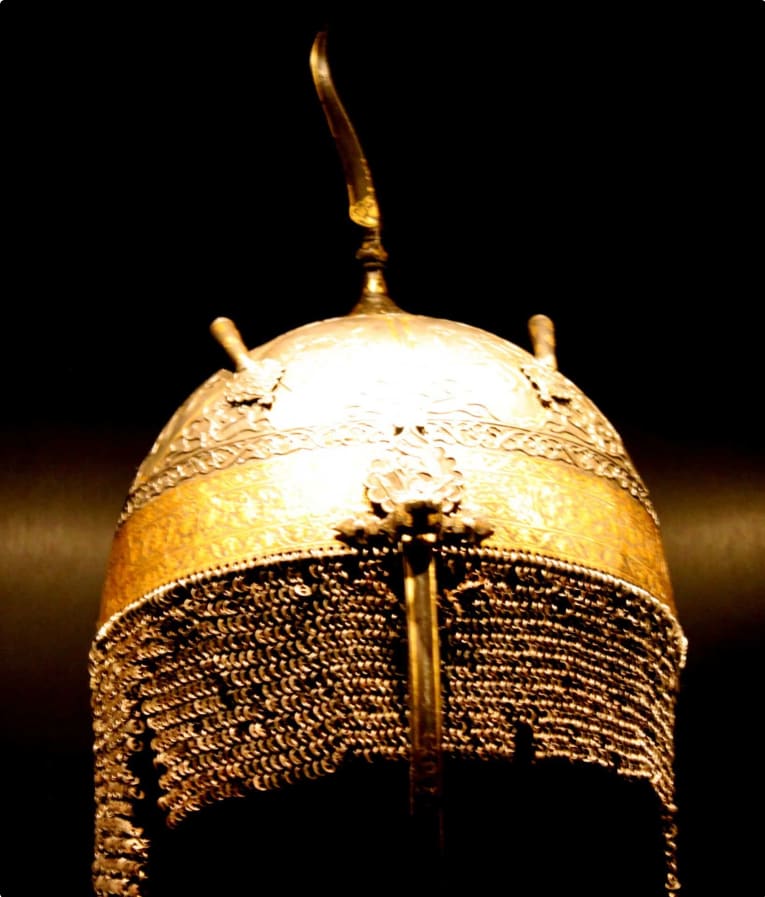
Sparkling treasures
From surviving pieces and documentary sources, a striking bejewelled style emerges. It seems this style developed during the Ottoman ‘Golden Age’ under the reign of Suleiman the Magnificent. Precious stones were set into the surface of objects, forging ostentatious pieces reserved for the elite. This includes Suleiman’s parade helmet, adorned with rubies and turquoises, his personal water flask, and sword.
Other popular designs include chasing (hammering lines into the surface), filigree (twisting threads of gold or silver), niello (the application of black inlay around engraving) and embossing. The characteristic floral or saz style was reflected in metalwork too. Leaves and blossoms not only adorned surfaces but inspired the shape of objects like candlesticks with pointed petals. Pieces unadorned with precious jewels were often nonetheless cast in impressive and ambitious shapes.
Armour was another significant example of metalwork in the Ottoman Empire, along with weapons for active warfare. Blades might be inlaid with calligraphy or gold arabesques, for example. A helmet of Sultan Bayezid II reveals an engraved inscription by a hammering technique called kuft-gari.
The Topkapi Palace would serve as the administrative centre and residence of the Ottoman Sultan and his court from about 1478 to 1856, when the court moved to the lavish Dolmabahce Palace. Today, the palace is preserved – along with several other important historic sites in Istanbul – as a UNESCO World Heritage Site.
The ‘Turkish Menace’: The Ottoman Empire in Western Art
Expansionist, powerful, unnervingly close, and (most importantly) Muslim, the Ottoman Empire was Europe’s great antagonist for centuries. At the height of its powers, the Ottoman Empire presented a very real threat to Christianity: they conquered the symbolically important Constantinople, made in-roads into the Balkans, and even laid siege to Vienna twice.
Particularly important was that the Ottoman Empire was an Islamic Empire. Christian Europe had been hostile to Islam from its inception. Much as in the Middle Ages, the generic ‘Saracen’ had been conjured to justify the Crusades; in Early Modern Europe, the ‘Turk’ became representative of all Middle Eastern Muslims.
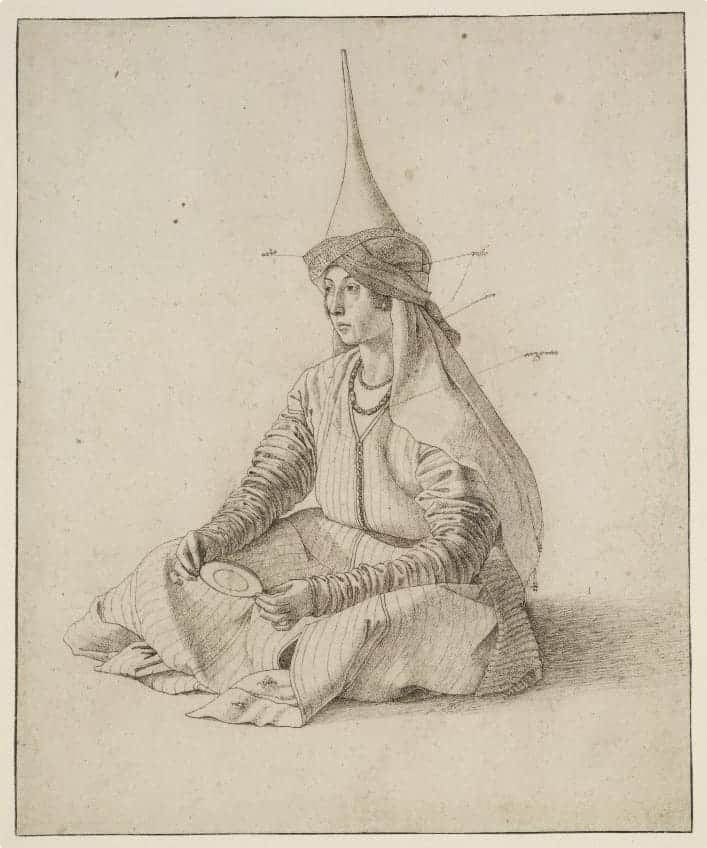
However, behind the Ottoman Empire’s status as Europe’s ‘enemy number one’ is a more complex story of cultural exchange. In late 15th century Istanbul, debate raged over the adoption of European Renaissance styles in painting (providing the backdrop for a murder mystery in the Nobel Prize winning author Orhan Pamuk’s My Name is Red, one of our ten books to read about Turkey). Under Mehmed the Conqueror, the Venetian painter Gentile Bellini was sent to Istanbul, where he painted several inhabitants of Mehmed’s court, including the Sultan himself. Though Mehmed’s successor, Bayezid II, was no fan of Western art, Bellini’s style would prove influential on the development of Ottoman art.
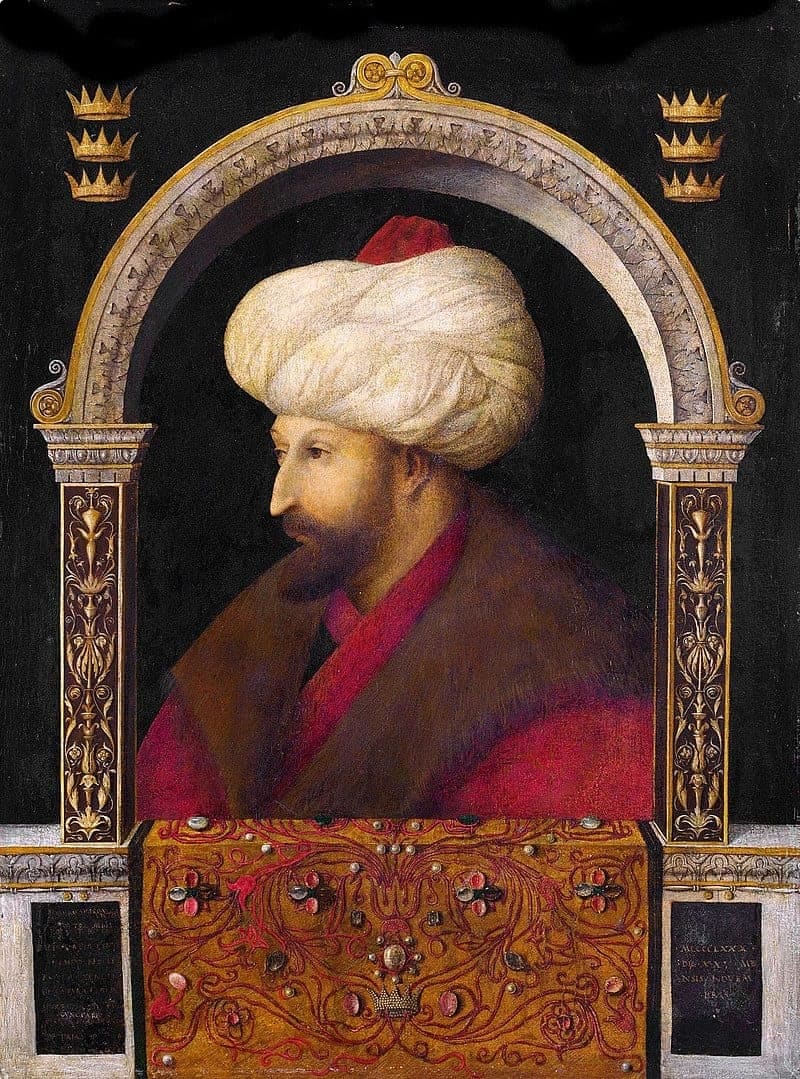
While the white turban Mehmed wore in Bellini’s painting signalled erudition in the Ottoman world, in Europe it became the uniform of the generic Turk. Subsequent European paintings portrayed Turkish people as a sinister ‘Other’. The first printed pamphlet on Johannes Gutenberg’s new printing press was a diatribe against the ‘Turkish menace’ – complete with drawings by Albrecht Dürer of a ‘teeth-baring, sword-clutching Turk’ (Sund, 2019).
Dürer also set a precedent in his Biblical scenes by portraying villains in Turkish dress – in his Apocalypse prints, Dürer portrays the Emperor Domitian, a notorious persecutor of Christians, in an (anachronistic) turban. By the 1530s, German artists frequently portrayed the Four Horsemen of the Apocalypse as wearing turbans and brandishing scimitars.

Representations of the Ottoman Empire differed in France, where the King approved of the Turkish ability to make trouble for their Habsburg rivals. The late 17th century saw a Parisian mania for turquerie. Following the introduction of coffee to Paris by Suleiman Aga, an Ottoman envoy, the first cafes were created, presided over by servers in turbans and Ottoman dress.
Following Ottoman defeat at Vienna in 1683, European portrayals of the Empire changed. The Ottoman Empire became associated with a languid excess and sexual hedonism rejected by (yet fascinating to) upstanding Christian men. No longer a pressing military threat, the Sultan was now ‘understood by Westerners to make the harem [his] primary field of operations’ (Sund, 2019).
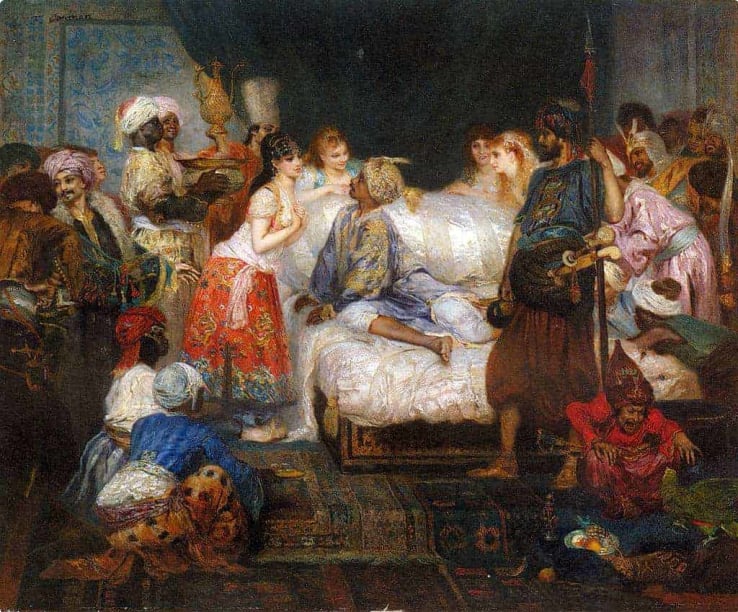
While the harem was in reality simply the residence of the Sultan and his family, it became a particular object of fascination for Western observers. According to Islamic law, the Sultan could have four legitimate wives, but he also supported as many as 300 concubines. Mistresses were generally captives taken in war or recruited from the imperial territories, who were then educated in Islam and the Turkish language, and promoted based on their looks and abilities. While Westerners believed that the Sultan could engage in debauchery at will, in reality every detail of harem life was governed by tradition and obligation, and most women in the harem served as ladies-in-waiting rather than concubines.
A particular fascination for Westerners was the fact that many women in the harem – from the Balkans or the Caucasian region – were considered to be ‘white’ according to the pseudo-scientific racial categories being developed in the 18th century. Theorists believed that Adam, Eve, and their children lived in the Caucasian mountains – from which the term ‘Caucasian’ as a synonym for the ‘white race’ comes. European observers in the 18th and 19th centuries became increasingly obsessed with the idea of ‘white slavery’ – women from the Caucasus (who were believed to be the world’s most beautiful) who became the favoured concubines of the Sultan.

For more on European representations of the Ottoman Empire (and others), read Judy Sund’s Exotic: A Fetish for the Foreign, which was used in the preparation of this section.
Visit Turkey with Odyssey Traveller
Odyssey Traveller organises cultural tours to Turkey. Our tours take you from Istanbul to Cappadocia in eastern Turkey, before winding back up along the west coast. On our journey, you will see many of Turkey’s most important historical sights: the Topkapi Palace, the Hagia Sophia, the Blue Mosque, and the Goreme Open Air Museum. Our trip also includes a walking tour through the ruins of ancient Ephesus. In order to ensure you have a memorable trip, our private tour takes a cruise down the Bosporus and visits the Grand Bazaar of Istanbul.
On our trip, we provide hotel accommodation along with a number of meals – breakfast, lunch, and dinner – so that you have many opportunities to try the many delicious varieties of Turkish food. In order to ensure an authentic and informed travel experience, our tours are led by an expert tour manager with the assistance of experienced local tour guides. Click here to see the full itinerary and sign up.
If you have a keen interest in history, you might like to explore our specialised program of history-in-depth tours. Or for those with a love of architecture, we also cater to modern tastes with our 21-day Scandinavian design tour.
Related Tours
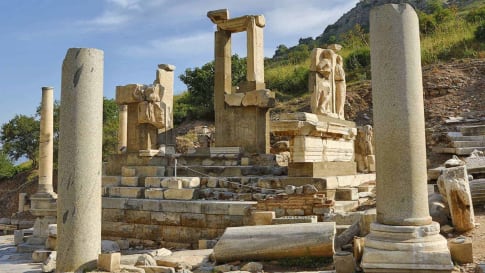
21 days
Apr, AugSmall group tour of Ancient Turkey
Visiting Turkey
As a travel company we seek to keep guests off the beaten path. Trips that are remembered for authentic experiences. Our small group journeys in Turkey are fully escorted by an experienced local guide and an Odyssey guide to give this type of experience whether at one of the many UNESCO World heritage sites explored or local bazaars. It is always about the adventure and memories that we will create.
From A$17,295 AUD
View Tour
20 days
Sep, AprCrete Small Group Tour: The Minoans
Visiting Greece
Crete rich in UNESCO World heritage sites this small group escorted tour provides a travel experience for guests with experienced local guides to remember. For senior couples or single travellers who seek to travel with other like minded people to destinations rich in ancient history then this in one of many small group journeys to be enjoyed.
From A$13,500 AUD
View Tour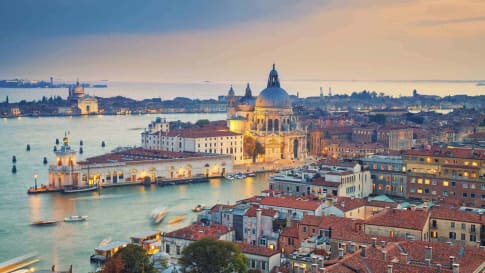
27 days
DecEuropean Cities Small Group History and Cultural Winter Tour
Visiting Albania, Croatia
An escorted tour A Journey that commences in Rome and takes in 12 destinations along its journey to Athens. This is an off season small group journey with like minded people. A small group tour across Southern Europe with local guides sharing authentic in-country authentic experiences for mature couples and solo travellers.
From A$17,295 AUD
View Tour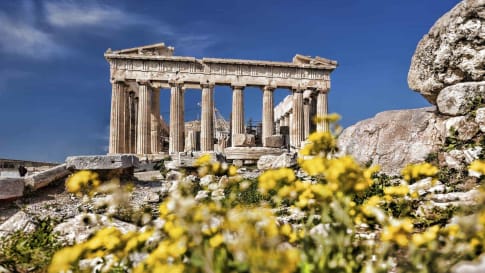
22 days
Apr, Sep, MayGreece small group escorted history tour
Visiting Greece
Our 22 day small group tour explores the land of great philosophers, myths, and legends. We will learn about the culture and heritage of modern Greece whilst exploring and learning Athens, which only found independence in its uprising from the Ottoman Empire in the 19th century.
From A$14,145 AUD
View Tour


